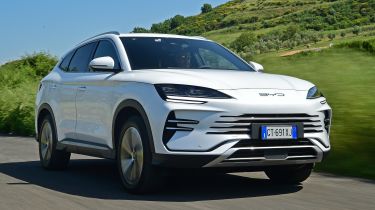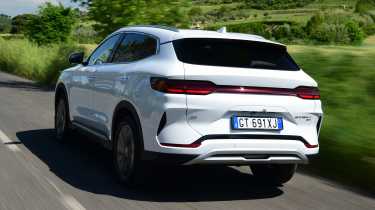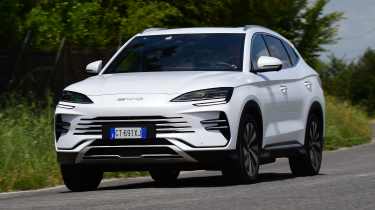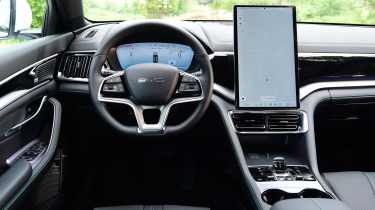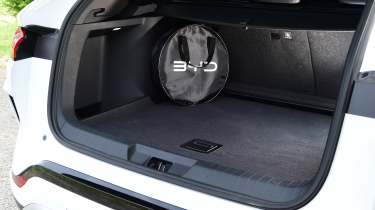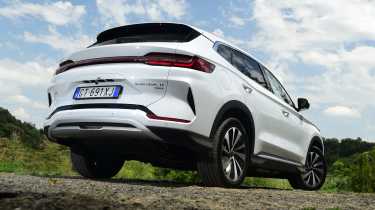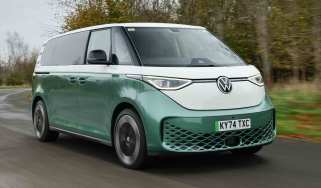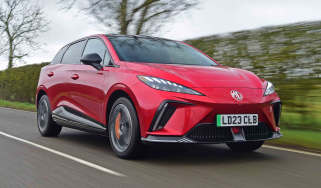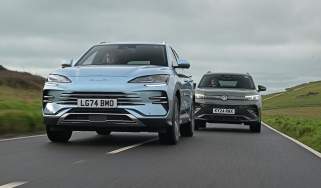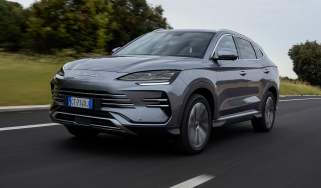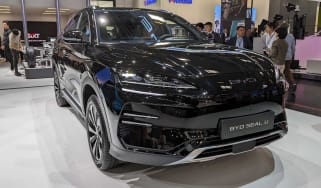BYD Seal U review
Spacious and attractively priced plug-in hybrid let down by lacklustre driving dynamics

Is the BYD Seal U a good car?
With a practical cabin, strong tech and low price, the BYD Seal U is not short of showroom appeal. However, the driving experience needs some work. Buyers in this part of the market don’t demand super-sharp handling, but the Seal U’s vague steering and inconsistent ride quality are real letdowns when you consider the brand’s all-electric BYD Seal saloon, with which this SUV shares a name, is much better in these aspects. However, look past its dynamic downsides, and the BYD will provide quiet, cost-effective and fuss-free family car transport.
|
Key specs | |
|
Fuel type |
Petrol, plug-in hybrid |
|
Body style |
Five-door compact SUV |
|
Powertrain |
1.5-litre 4cyl petrol + e-motor |
|
Safety |
5-star Euro NCAP (2023) |
|
Warranty |
6yrs/93,750 miles |
How much does the BYD Seal U cost?
BYD (that’s ‘Build Your Dreams’ if you didn’t already know that) is one of the latest Chinese brands to hit Europe. Despite only being over here for a couple of years, the ambitious firm has embarked on a new model offensive, mainly concentrating on EV models that offer style, value and plenty of tech.
The Seal U, unlike its Seal saloon sibling, is a plug-in hybrid, mid-sized SUV aimed at one of the most crowded corners of the new car market. Although it shares its name with the all-electric Seal, the high-riding Seal U has virtually nothing in common with its four-door namesake.
Currently, the Seal U is available in three trim levels - entry-level Boost, mid-range Comfort, and flagship Design. The former is front-wheel drive only, while the latter combines a petrol internal combustion engine with two electric motors for sports car-rivalling pace.
More reviews
Pricing is very competitive, with the standard Boost version coming in at just over £33,000, while the top-of-the-range Design is a whisker under £40,000. Sitting between these two at about £35,000 is the Comfort, which features the same powertrain as the Boost but has a larger 27kWh battery for up to 78 miles of EV running.
Although it’s called a plug-in, the Seal U is effectively a range-extender. The petrol unit under the bonnet can be called upon to drive the road wheels directly, but most of the time it's the electric motors that are doing all the work. As a result, the BYD drives with the smoothness of an EV, with the engine only cutting in to act as a generator and keep the car’s battery topped up.
Engines, performance & drive
The Seal U can be had as a single-motor, front-wheel drive, or a twin-motor all-wheel drive. Both versions feature a 1.5-litre petrol four-cylinder, which, in the case of the latter, benefits from the addition of a turbocharger to increase power.
As you’d expect, the all-wheel drive car is the quickest version, with its front motor and rear motor combining with the 1.5-litre petrol engine to deliver a rippling 319bhp in total and a 0-62mph in just 5.9 seconds.
For the two-wheel drive, car there’s a less powerful combined output from the single electric motor and naturally aspirated petrol engine of 215bhp, resulting in a less sprightly 8.9 seconds sprint for the standstill to 62mph benchmark.
Yet, in the real world, the performance difference is harder to detect thanks to the instant torque of the electric motors. The four-wheel drive Design model does have a definite muscle advantage when zapping past slower traffic, but in day-to-day use, both versions feel brisk and benefit from a seamless transition between the various power sources.
For the most part, the BYD Seal U is refined and quiet when running on electricity, but the petrol engine can become intrusive when it kicks in at low speeds as a generator for the battery. On the motorway, engine noise is much less noticeable, but that’s because there is, unfortunately, a lot of road generated by the standard 19-inch wheels, along with wind noise caused by the large door mirrors.
Although the BYD Seal U comes with a few different drive modes, we were hard-pressed to notice much of a difference when cycling through them. Sport mode makes the throttle a little more responsive, and you have to adjust the weighting of the steering separately via an on-screen menu – although the different settings fail to add extra feedback or accuracy to the electrically assisted set-up.
Sadly, the suspension isn’t up to the same standards as the powertrain. First impressions are of a car that unashamedly prioritises comfort over agility – and in an SUV such as this, we’ve no real issue with that. However, what initially feels like a soft set-up quickly exposes itself as one that offers little control (and therefore confidence) across various surfaces.
On fast, undulating tarmac, the body occasionally feels like it’s floating on top of the chassis, appearing disconnected from the road. But while this is no major cause for concern on the motorway, A and B roads pose a bigger problem; hit a bump or odd camber mid-corner and it completely upsets this BYD’s balance – an issue only exaggerated by the car’s noticeable body roll. It’s not dangerously sloppy, but you sometimes feel like you’re holding on and hoping for the best.
Then there’s the constant pitter-patter that’s evident underneath you. It’s not so bad that you’ll notice shocks through the base of your seat, but even on visibly smooth roads, the Seal U never truly settles.
|
Model |
Power |
0-62mph |
Top speed |
|
BYD Seal U DM-i Boost |
215bhp |
8.9 secs |
106mph |
|
BYD Seal U DM-i Design |
319bhp |
5.9 secs |
112mph |
MPG, emissions & running costs
On paper, PHEV models deliver some eye-catching fuel efficiency and CO2 figures – and the Seal U is no exception. The addition of a battery and either one or two electric motors allows the cars to travel reasonable distances in EV mode, shutting off the petrol engine and potentially slashing your bills.
Currently, the entry-level Boost and top-spec four-wheel drive Design models feature an 18.3kWh battery that powers their electric motor. For the entry-level car, BYD claims a range of up to 50 miles of electric driving, while the more powerful flagship version’s more powerful motors result in a WLTP range of 43 miles. The mid-range Comfort has a larger 26.6kWh battery that’s good for up to 77 miles of electric range, which will be useful for those with longer commutes.
As a result, the Seal U promises staggering combined fuel returns of anything between 313mpg and 235mpg. Of course, unless you plug in frequently and complete most of your journeys on battery power, then you’ll struggle to match these numbers.
According to BYD, the plug-in hybrid Seal U can accept up to 18kW charging speeds, but this requires a three-phase electricity supply that most domestic homes don’t have, so most owners will likely use a 7kW wall box. That will mean it’ll take around four hours to fully recharge the 26.6kWh Comfort version, and close to three hours to ‘fill up’ the 18.3kWh Boost and Design versions.
For company car users, the official EV range of the Seal U is more than 40 miles regardless of model, meaning it’s rated at a cash-saving eight per cent for Benefit-in-Kind tax. And because neither model breaches the £40,000 threshold for road fund licence, private buyers are spared the £410 annual surcharge for an annual tax disc. In fact, owners get a £10 discount compared to traditional petrol and diesel-engined machines.
Insuring the BYD is unlikely to be any more costly than its immediate plug-in rivals, such as the Toyota RAV4 or the Honda CR-V. The entry-level Boost is rated as group 32, while the pricier and more powerful Design falls into group 40.
Our experts expect that this plug-in hybrid SUV will retain between 52 to 54 per cent of its original value after three years or 36,000 miles (whichever comes first), with Boost model being the strongest performer come trade-in time.
|
Model |
MPG |
CO2 |
Insurance group |
|
BYD Seal U DM-i Boost |
313.0mpg |
21g/km |
32 |
|
BYD Seal U DM-i Design |
235.0mpg |
26g/km |
40 |
Design, interior & technology
Given the effort BYD put into the design of the sleek Seal saloon, its SUV namesake is a bit of a disappointment. There’s nothing wrong with the rounded lines of the Seal U, it’s just a little generic and bland – you’re unlikely to turn any heads when cruising down the high street or when stopped at the traffic lights. Even the inclusion of standard metallic paint fails to boost the car’s visual appeal.
The same can’t be said for the interior, which is smartly styled and packed with premium materials. Quality is good throughout, and the soft-touch materials on the dashboard, centre console and doors are easily a match for Europe’s best. All the seats are supportive and plushly finished in convincing vegan faux leather, while those in the front are heated and ventilated as standard.
A standard-fit glass roof floods the cabin with light during the day, while ambient cabin lighting creates a classy ambience after dark. The latter not only allows you to choose the colour of your backdrop, it can also be set to pulse rhythmically – although some might find this something of a distraction.
Ahead of the driver is a comprehensive 12.3-inch TFT instrument cluster that can be customised to show everything from driving data to sat-nav info. Both versions also get a standard head-up display that projects your speed onto the windscreen within the driver’s line of sight.
Sat-nav, stereo and infotainment
The Seal U’s infotainment system is one from other BYD models, and is effectively lifted lock-and-stock from the BYD Atto 3. The vast 15.6-inch rotating display runs on the same super-fast processor that makes it responsive to your inputs.
While the rotating screen and its added complication is a bit of an ice-breaker with passengers new to the car, it is something of a gimmick. After the initial interest watching it spin on its axis, most users will probably default to its landscape orientation as it doesn’t obstruct your view forward in the same way as the portrait layout does.
As with the other BYD models, there's a handy shortcut to some basic climate control adjustments, allowing you to tweak the temperature using a menu in the digital driver’s instrument cluster and the buttons on the steering wheel. However, you do have to exit whatever screen you’re on within the main display in order to access all of the climate control functions, which is a touch irritating.
On the plus side, both versions get a 10-speaker Infinity sound system as standard. It’s not the richest sounding set-up, but it offers powerful volume, and the overall sound quality is very good.
Boot space, comfort & practicality
|
Dimensions | |
|
Length |
4,775mm |
|
Width |
1,890mm |
|
Height |
1,670mm |
|
Number of seats |
5 |
|
Boot space |
425-1,440-litres |
At 4,775mm long, the BYD Seal U is one of the longer SUVs in the class, stretching the measuring tape around 150mm more than a Toyota RAV4. It’s also a little wider than the competition, although it’s no taller.
Either way, the Seal U offers generous interior space for occupants, with those in the back being particularly well-served. There’s lots of leg and headroom, while the lack of any transmission tunnel means sitting three adults across the rear bench isn’t the form of torture it can be in smaller rivals.
Those sitting up front are equally well catered for, with plenty of room to stretch out. The passenger’s seat gets four-way electric adjustment, while the driver’s eight-way settings and reach-and-rake steering make finding the perfect driving position a doddle. There’s also a heated steering wheel to keep fingers toasty on frosty mornings.
There’s a decent amount of family-friendly storage, with a large glovebox, deep door bins and a lidded cubby between the front seats that doubles as an armrest. For front seat occupants, there are a pair of cupholders set behind the gear selector, while those for rear seat passengers are located in the fold-down armrest.
Like selected Genesis, Hyundai and Kia models, the BYD offers Vehicle-to-Load (V2L) charging, which allows you to top-up the batteries of more powerful electrical items, such as e-bikes, or even power domestic equipment like a coffee machine or a games console.
Despite its large exterior dimensions, the 425-litre boot capacity of the Seal U is one of the smallest in the class – and is exceeded by many models in the sector below. The hatchback boot opening is at least wide, and there are some deep cubbies on either side of the boot, but there’s a fairly prominent load lip. And while the rear bench has a 60/40 split fold function, there are no handy release levers in the load compartment,, and the seat backs don’t fold totally flush, meaning the 1,440-litre capacity is compromised.
The Seal U doesn’t have a great towing capacity. In its standard two-wheel drive form, it can only manage a braked trailer of 750kg, while the four-wheel drive is rated to pull up to 1,300kg. That’s not very much for owners who want to pull a decent-sized trailer or caravan, and they’ll be better served by plug-in rivals such as the Honda CR-V and Ford Kuga.
Safety & reliability
Despite being a new manufacturer in Europe, BYD has made a strong impression with safety specialists Euro NCAP. Like all of the brand’s models, it attracted a strong five-star score when it was tested, with particularly impressive results for its protection of occupants and vulnerable road users.
The Seal U was also marked highly for its assistance systems – and it’s not hard to see why. All models get a vast array of advanced driver aids, including adaptive cruise control, autonomous emergency braking and cross traffic alerts both front and rear. Better still, the firm’s engineers have tweaked some of these features to be easier to turn off and less intrusive than their applications in the other BYD models we’ve tested.
Given that BYD is such a new brand, it’s perhaps not surprising that it hasn’t appeared in our Driver Power satisfaction survey. As a result, its cars are something of an unknown quantity when it comes to reliability. That said, all the examples we’ve tried have largely been solidly built and free from quality niggles or electrical glitches, while our experience with an BYD Atto 3 during a long term test suggested durability shouldn’t be an issue.
If further peace of mind is needed, then it’s worth bearing in mind that the U gets a six-year and 93,750-mile warranty. That’s not quite as generous as Kia’s seven-year guarantee, but it beats the cover offered by most of BYD’s mainstream and premium rivals. The battery pack is covered by a separate eight-year warranty (up to 125,000 miles for the 18.3kWh version and 200,000 miles for the 26.6kWh model), which guarantees that the battery won’t drop below 70 per cent of its original capacity over that time.
|
Key standard safety features |
Euro NCAP safety ratings |
|
|
BYD Seal U alternatives
The BYD Seal U arrives in a market awash with SUVs of many shapes and sizes, and there are even many plug-in hybrid and hybrid SUVs to choose from for low running costs. However, with its mix of generous exterior dimensions and attractively low price, the Seal U attracts rivals from various classes.
For instance, in terms of interior space the BYD is closely matched to established Japanese plug-in such as the Honda CR-V, Toyota RAV4 and Ford Kuga.
Yet consider the car’s pricing and the list of competitors is stretched to include the Hyundai Tucson and Kia Sportage, which both have plug-in options, as well as more traditionally-powered machines such as the Nissan Qashqai and Skoda Karoq.
Frequently Asked Questions
BYD offers a generous six-year and 93,750-mile warranty on all of its cars.
